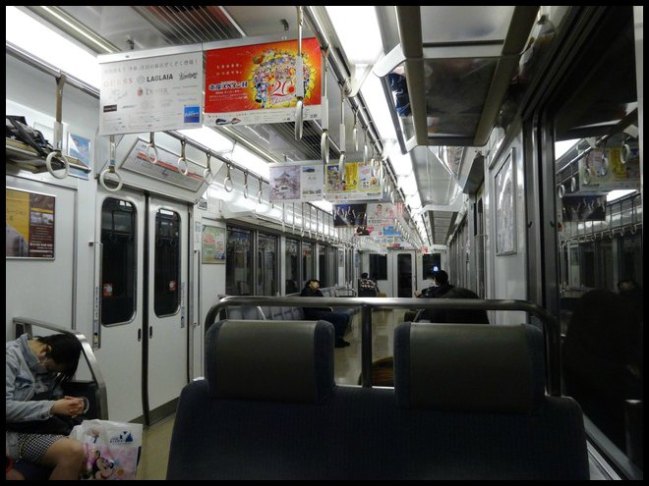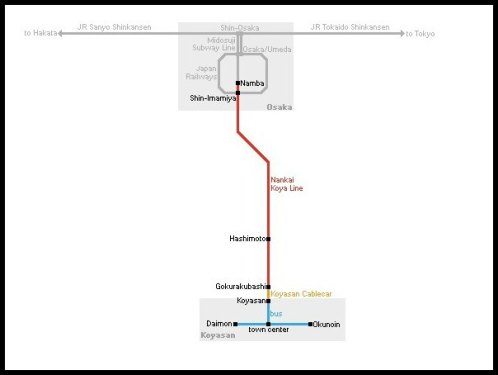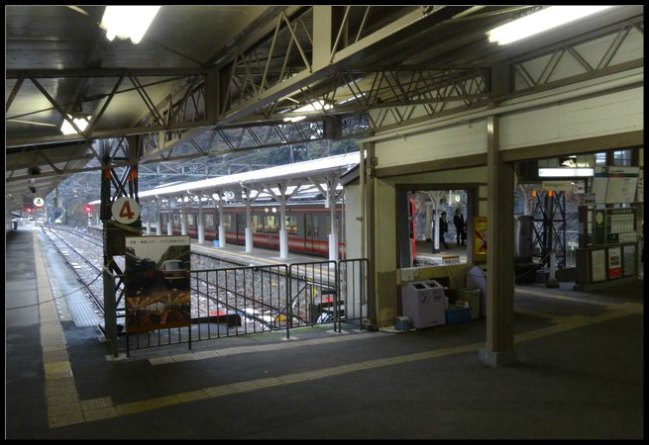
Armed with our Koyasan – World Heritage tickets we got to Namba Station (Osaka) in time to catch the 7.24am train for our day-trip to Koyasan. With one change at Hashimoto (km 40.1) we would, and being Japan we did, arrive at Gokurakubashi Station some 60km away on schedule just over an hour and a half later. Here we would transfer to the Koyasan Cablecar for the short ride up to Koyasan Station where we would then take a bus into the township.
Being a Sunday, we had expected to encounter quite a crowd at Namba bound for Koyasan. Scrutinising the handful of people who had gathered on the platform by the time our suburban train arrived none stood out as tourists or pilgrims.  Perhaps Osaka’s other tourists and its pilgrims had checked a different weather forecast than I had the evening before! Assuming they hadn’t, I began to wonder if we were about to take the wrong train. Being pretty sure we were not, we got into the train and joined a handful more sleeping commuters for the pleasant though certainly not spectacular trip to Hashimoto, through the outer surburbs of Osaka and some low level arable land.
Perhaps Osaka’s other tourists and its pilgrims had checked a different weather forecast than I had the evening before! Assuming they hadn’t, I began to wonder if we were about to take the wrong train. Being pretty sure we were not, we got into the train and joined a handful more sleeping commuters for the pleasant though certainly not spectacular trip to Hashimoto, through the outer surburbs of Osaka and some low level arable land.

Hashimoto Station was well signed posted in Japanese and English, as were all stations along the route, so there was no risk of us continuing on by mistake. Alighting on the platform, a member of staff, easily identifying us as visitors, directed us across the platform to the nice gleaming red train that would take us to Gokurakubashi.

Leaving Hashimoto, we crossed the Kiwagawa River and soon started our trip further inland along the much smaller Fudotanigawa River.
Again our train was almost empty as we passed through small, pretty villages, set among hills and brightly coloured by an abundance of cherry trees in blossom. Over the 20kms to Gokurakubashi we climbed from 90 metres to 539 metres. What had started out a pleasant morning in Osaka turned into a rather cold and ugly morning with sleet and snow falling by the time we pulled into Gokurakubashi.
Should you not have a Koyasan – World Heritage Ticket, the standard one-way fare between Namba and Gokurakubashi was Y870 in July 2016.
Here we transferred, all of around 50 metres walk, to the Koyasan cablecar which would take us up the mountainside to Koyasan.

When transferring, do not exit the ticket gate, rather head directly to and board the cablecar – above picture taken from the cablecar entrance.
The ride, with an ascent of 320 metres, took about five minutes and had it not been included in our Koyasan – World Heritage ticket it would have cost Y390 one-way.
As the cablecar makes its way up through a forested area there is not much of a view and given the almost blizzard like conditions on the day we took it, there was no view.

The cablecar is scheduled to connect with all arriving and departing trains but don’t dilly dally or you will miss the cablecar or, more seriously, your train on departure.
From Koyasan station, it is a ten minute bus ride into the town centre (Y290 to Senjuinbashi bus stop if you don’t have a Koyasan – World Heritage Ticket). Note that you are not allowed to walk along the the first km or so of the road which connects the cablecar station with the town centre. Accordingly, you must take the bus to at least its first stop – Nyonindo. A daily bus pass, for those without the Koyasan – World Heritage ticket, can be bought at the station for Y830. For more details on bus travel within Koyasan see my separate review – Koyasan – Getting around by Bus.
Should you prefer, and be up to it, there is a pilgrimage (walking) trail from Gokurakubashi to Nyonindo. I would suggest, a better option on the way down!
Undeterred and with little choice we took the cablecar for our short trip to Koyasan Station.
For my next KOYASAN review click HERE.
To start reading at the beginning of my Koyasan reviews click HERE.






I loved our train journeys in Japan! But it seems odd to encounter both cherry blossom and a blizzard on the same day 😉
LikeLiked by 1 person
Yes, the latter was very unseasonal..
LikeLike
Heheh… guess we were privileged to drive there instead of taking the train.
But then, the train would have been an adventure in itself!
LikeLiked by 1 person
The train trip was fine though not spectacular.
LikeLiked by 1 person